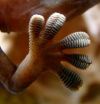(Press-News.org) CINCINNATI—Oxidative stress is a significant predictor for hip fracture in postmenopausal women, according to new research led by University of Cincinnati (UC) epidemiologists.
The research, appearing online ahead of print in the Journal of Bone and Mineral Research, was led by Tianying Wu, MD, PhD, an assistant professor in the UC College of Medicine Department of Environmental Health, and Shuman Yang, a postdoctoral fellow in the department. They collaborated with researchers from the Harvard School of Public Health and Harvard Medical School.
"To our knowledge, this is the first prospective study among postmenopausal women demonstrating that oxidative stress was a significant predictor for hip fracture," says Wu, the study's corresponding author.
Oxidative stress is defined as physiological stress on the body that is caused by the cumulative damage done by free radicals, which are inadequately neutralized by antioxidants. Free radicals are unstable molecules that react with other substances in the human body to damage cells or organs.
Oxidative stress occurs naturally, but environmental factors such as natural and artificial radiation, toxins in air, food and water and miscellaneous sources such as tobacco smoke can add to the overall burden and defeat the body's antioxidant defenses.
The researchers assessed oxidative stress by measuring fluorescent oxidation products (FlOP) in blood plasma. FlOP reflects a mixture of oxidation products from lipids, proteins and DNA and can be measured by a fluorescent spectrophotometer.
Researchers studied participants in the Nurses' Health Study, which began in 1976 with funding from the National Institutes of Health (NIH). Participants are female nurses who periodically respond to questionnaires and submit samples.
The researchers studied 996 women aged 60 or older at baseline blood collection (1989-1990). Plasma FlOPs were measured at three excitation/emission wavelengths: 360/420 nm (nanometers), named as FlOP_360; 320/420 nm, named as FlOP_320; and 400-475 nm, named as FlOP_400.
FlOP_360 represents oxidation products that are generated from oxidized phospholipids or from lipid oxidation products reacting with proteins. FlOP_320 is formed when oxidation products such as lipid hydroperoxides, aldehydes and ketones react with DNA in the presence of metals. FlOP_400 reflects the interaction between malondialdehyde (a specific marker for lipid oxidation), proteins and phospholipids.
Of the three wavelengths, researchers found that baseline levels of FlOP_320 products predicted risk of future hip fracture in the study cohort. (No association was found with FlOP_360 and FlOP_400.) Increased FlOP_320 was associated with greater risk of hip fracture; women in the upper 30 percent of FlOP_320 readings were found to have 2.67 times the risk of hip fractures of those in the bottom 30 percent.
"Because FlOP_320 is generated in the presence of metals, its strong association with hip fractures may reflect the co-existing effect of reactive oxygen species and heavy metals," says Wu, who notes that the other FlOP products can be generated without metals.
Hip fracture is associated with substantial cost, as well as higher risk of disability, co-morbidities and mortality than any other fractures. Current fracture risk assessment uses traditional risk factors such as age and presence of osteoporosis, but Wu sees FlOP_320 playing an important role in risk assessment.
"If our findings are confirmed in other studies, adding this marker into the existing fracture assessment model could improve the prediction of hip fracture in postmenopausal women," she says.
INFORMATION:
The study was funded by grants from the American Heart Association, the NIH's National Heart, Lung and Blood Institute and National Cancer Institute and the UC Center for Environmental Genetics, funded by the NIH's National Institute of Environmental Health Sciences.
Oxidative stress is significant predictor for hip fracture, research shows
2014-08-12
ELSE PRESS RELEASES FROM THIS DATE:
Fires in Northern Washington State
2014-08-12
The Pacific Northwest has been inundated with wildfires most stemming from lightning strikes during summer storms. Four of these wildfires can be seen in this natural-color Aqua satellite image collected by the Moderate Resolution Imaging Spectroradiometer, MODIS, instrument aboard. This image was taken on August 11, 2014. Actively burning areas, detected by MODIS's thermal bands, are outlined in red.
The Upper Falls wildfire was started by a lightning strike on August 03. It is located 17 Miles North of Winthrop WA, 37 miles Northwest of Omak, WA and has grown to ...
NASA sees a weaker Tropical Storm Julio far north of Hawaii
2014-08-12
Tropical Storm Julio continues to weaken as it moves through cooler waters of the Central Pacific Ocean. NASA's Terra satellite passed over Julio and saw that the bulk of the clouds and precipitation were being pushed to the34 north of the center as the storm tracked far north of the Hawaiian Islands.
NASA's Terra satellite passed over Julio on August 11 at 21:25 UTC (5:25 p.m. EDT) and the Moderate Resolution Imaging Spectroradiometer or MODIS instrument aboard took a visible picture of the storm. The MODIS image revealed a circular center, but most of the clouds and ...
Copper foam turns carbon dioxide into useful chemicals
2014-08-12
PROVIDENCE, R.I. -- A catalyst made from a foamy form of copper has vastly different electrochemical properties from catalysts made with smooth copper in reactions involving carbon dioxide, a new study shows. The research, by scientists in Brown University's Center for the Capture and Conversion of CO2, suggests that copper foams could provide a new way of converting excess CO2 into useful industrial chemicals.
The research is published in the journal ACS Catalysis.
As levels of carbon dioxide in the atmosphere continue to rise, researchers are looking for ways to make ...
Geckos use toe hairs to turn stickiness on/off
2014-08-12
WASHINGTON D.C. Aug. 12, 2014 -- If you've ever spent any time watching a gecko, you may have wondered about their uncanny ability to adhere to any surface -- including upside down on ceilings. It turns out the little lizards can turn the "stickiness" of toe hairs on the bottom of their feet on and off, which enables them to run at great speeds or even cling to ceilings without expending much energy.
In the Journal of Applied Physics, from AIP Publishing, Oregon State University (OSU) researchers describe their work exploring the subtleties of geckos' adhesion system ...
No excess baggage: Antarctic insect's genome, newly sequenced, is smallest to date
2014-08-12
COLUMBUS, Ohio – Scientists who sequenced the genome of the Antarctic midge suspect the genome's small size – the smallest in insects described to date – can probably be explained by the midge's adaptation to its extreme living environment.
The midge is a small, wingless fly that spends most of its two-year larval stage frozen in the Antarctic ice. Upon adulthood, the insects spend seven to 10 days mating and laying eggs, and then they die.
Its genome contains only 99 million base pairs of nucleotides, making it smaller than other tiny reported genomes for the body ...
Scientists discover the miracle of how geckos move, cling to ceilings
2014-08-12
CORVALLIS, Ore. – Researchers at Oregon State University have developed a model that explains how geckos, as well as spiders and some insects, can run up and down walls, cling to ceilings, and seemingly defy gravity with such effortless grace.
The solution, outlined today in the Journal of Applied Physics, is a remarkable mechanism in the toes of geckos that use tiny, branched hairs called "seta" that can instantly turn their stickiness on and off, and even "unstick" their feet without using any energy.
These extraordinary hairs contribute to the ability of geckos to ...
WSU researcher sees survival story in Antarctic fly's small genome
2014-08-12
PULLMAN, Wash.—Few animals can boast of being as tough as the Antarctic midge. Its larvae develop over not one but two Antarctic winters, losing nearly half their body mass each time. It endures high winds, salt, and intense ultraviolet radiation. As an adult, the midge gets by without wings and lives for only a week or so before starting its life cycle all over again.
And as Joanna Kelley has learned, it does this with the smallest insect genome sequenced so far.
"It's tiny," said Kelley, a Washington State University assistant professor, who recently sequenced and analyzed ...
Transgender relationships undermined by stigma
2014-08-12
PROVIDENCE, R.I. — Researchers who looked at the impact of discrimination, poverty and stigma on the mental health and relationship quality of transgender women and their male romantic partners found that social and economic marginalization not only takes a psychological toll on each person individually but also appears to undermine them as a couple.
It is difficult to be a transgender woman in the United States. Prior research has shown that they generally face high risks of depression, financial hardship, and discrimination, said study lead author Kristi Gamarel, a ...
Majority of Quebec children placed in out-of-home care are reunited with their family
2014-08-12
The majority of children in Quebec's youth protection system who are placed in out-of-home care (family foster care, or in a group or rehabilitation centre) are reunited with their "natural" families within 6 months, according to a study led by Professor Tonino Esposito of University of Montreal's School of Social Work. However, younger children, specifically those aged 2 to 5 years old at initial placement, have the lowest likelihood of returning to live with their natural families over time. "All placed children, irrespective of age, are less likely to return to live ...
Scared of crime? Good.
2014-08-12
EAST LANSING, Mich. -- In the past half-century, fear of crime in the United States has fueled "white flight" from big cities, become known as a quality of life issue and prompted scholars and law enforcement experts to address ways of reducing this fear.
But a study by a Michigan State University criminologist challenges this longstanding theory by arguing that a healthy fear of crime is, in fact, a good thing.
The study, published online in the journal Justice Quarterly, suggests adolescents who are more fearful of crime are less apt to become victims and offenders ...







